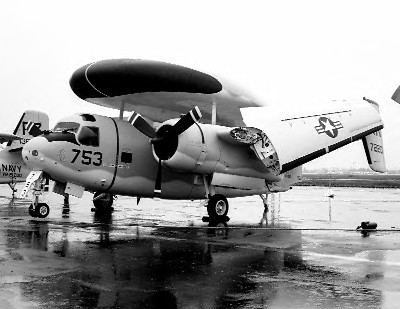Lying dormant for nearly four years after XWF-1 contract was cancellend, the idea of developing an airborne early warning aircraft based on the Tracker was resurrected by the Preliminary design group at Bethpage in the spring of 1955. The revised concept began mostly accidentally when an avionics engineer, Samuel Rogers, and a performance and aerodynamic engineer, Joseph Lippert Jr, sought ways of installing a new Hazeltine search radar (which eventually was produced as the AN/APS-82) and its bulky rotating antenna in an aircraft small and light enough to operate from carriers.
Sixteen configurations, using either the AF Guardian, the S2F Tracker or entirely new designs, were quickly evaluated before the conclusion was reached that a configuration based on the Tracker and a large dorsal radar dome was attractive. Layout and preliminary performance estimates were then prepared by Joe Lippert and appeared to validate the concept. Nevertheless wind-tunnel testing was needed to verify drag calculations and handling characteristics for the radome-equipped aircraft. However, as no immediate Navy requirements for such a system were known to exist, the government funding would not be forthcoming and only limited work could be funded by the company. Fortuitously, a way was found for adding wind-tunnel testing on to S2F development work scheduled to be undertaken late in the summer of 1955. Wind-tunnel results were encouraging but indicated that a rearward radome extension would be necessary to reduce drag even though there might be some loss of radar effectiveness while looking aft.
Meanwhile, planning to initiate a design competition during the following year, BuAer had begun developing requirements for carrier-based airborne early warning air intercept control (AEW/AIC) aircraft to be equipped to detect and report distant airborne targets and to vector fighters into intercept positions. Like other manufacturers, Grumman was aware of the impending design competition and during the fall of 1955 offered a development of the S2F as an interim AEW aircraft. Preliminary performance data based on the work done by Joe Lippert were submitted by Grumman in November and soon after BuAer issued a letter of intent for two prototypes. On that strength, a team led by William Rathke began formal work on Design 117.
As the design of the AEW aircaft was being refined during the winter of 1955 and spring of 1956, numerous changes were made. Notably, the TF-1 replaced the S2F-1 as the airframe to be used for the radar platform as its more capacious fuselage provided space for additional electronic equipment and for the crew. Twin fins and rudders replaced the single vertical surfaces of the Trader. Moreover, to clear the radome, wing folding had to be redesigned and, in place of the TF-1's vertically folding wings, the TF-1W (later designated TF-1 and E-1B) received "sto-wing" folding to the rear and alongside the rear fuselage as first used by Grumman on the XF4F-4. Housing a 17-ft 6-in diameter radar scanner rotating at 6 rpm, the 20-ft by 30-ft fixed aerofoil-section radome was mounted on a forward fuselage pylon, strut-braced to the wings and fuselage, and attached to a stubby central fin.
Even though the wind-tunnel results led to the modification of a TF-1 Trader into an aerodynamic prototype for the Tracer as described in the earlier chapter. Test pilots first flew the prototype on December 17, 1956 and reported favorably on its inflight behavior.
Trials with this aerodynamic prototype confirmed that the AEW aircraft would handle well and that its large radome would in fact contribute to lift. Nevertheless, the program proceeded conservatively, with manufacture of forty WF-2s on order being delayed pending further development and testing of the complex electronics. Finally, the first WF-2 was flown on March 1, 1958. Five more aircraft were delivered in that year, and twenty-two were accepted in 1959 before the type was cleared for Service use.
Compared with previous carrier-based aircraft fitted with less sophisticated radar, the WF-2 introduced several new capabilities. In particular, its antenna was stabilized to provide a means of determining a target's height; its displays were ground stabilized to ease detection, tracking, and intercepts; its radar relay used UHF instead of VHF; and an airborne moving target indicator (AMTI) was provided to cancel sea returns when over water. All of these features were carefully validated during a lengthy test and development program culminating in BIS trials.
The Tracer attracted interest abroad, with Grumman notably working during the summer of 1959 on a proposal tailored to the requirements of the Royal Swedish Air Force and incorporating some Swedish equipment. However, neither this G-117B study nor studies for other air forces led to design sales.
A total of 88 Tracers were built by Grumman between February 1958 and September 1961. Eventually, all Tracers were phased out and replaced by the more advanced E-2C Hawkeye.

Manufacturer: Grumman
Powerplant: Two 1,525 hp Wright R-1820-82A radials
Wingspan: 72 ft 4 in
Length: 45 ft 4 in
Height: 16 ft 10 in
Empty weight: 20,638 lbs
Max weight: 26,600 lbs
Maximum speed: 227 mph at 4000 ft
Cruising speed: 163 mph
Climb rate: 1,120 ft/min
Range: 1,010 miles
Service Ceiling: 15,800 ft
